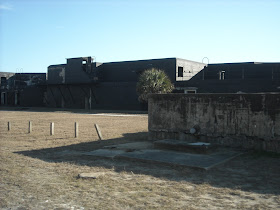The first fort on Sullivan's Island was still incomplete when Commodore Sir Peter Parker and nine warships attacked it on June 28, 1776. After a nine-hour battle, the ships were forced to retire. Charleston was saved from British occupation, and the fort was named in honor of its commander, Colonel. William Moultrie. In 1780 the British finally captured Charleston, abandoning it only on the advent of peace.
In December 1860 South Carolina seceded from the Union, and the Federal garrison abandoned Fort Moultrie for the stronger Sumter. The Civil war left Fort Moultire was buried under sand used to fortify its walls.
Fort Moultrie was modernized in the 1870s, employing concepts developed during the war. Huge new cannon were installed, and magazines and bombproofs were built of thick concrete, then buried under tons of earth to absorb the explosion of heavy shells. In 1885, President Grover Cleveland appointed Secretary of War William C. Endicott to head a board to review the coastal defenses in light of newly developing weapons technology. The system that emerged, named for Endicott, again modernized the nation’s fortifications. New batteries of concrete and steel were constructed in Fort Moultrie. Larger weapons were emplaced elsewhere on Sullivan's Island, and the old fort became just a small part of the Fort Moultrie Military Reservation that covered much of the island.
(Excerpted from the National Park Dept. website)






No comments:
Post a Comment